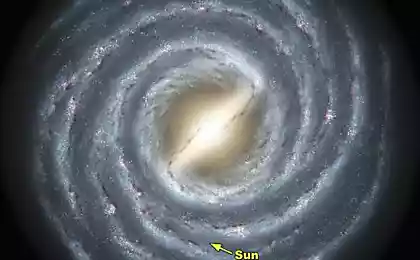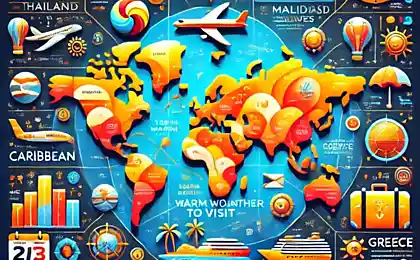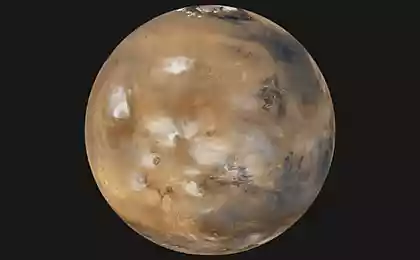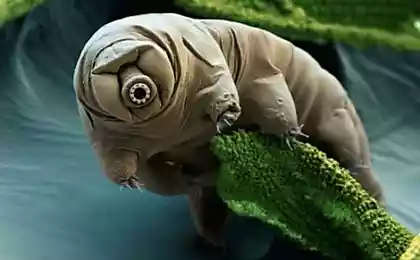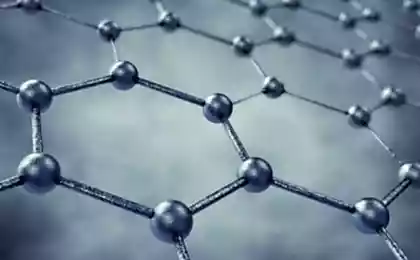731
Weather on the planets of the Solar System (9 photos)
In fact, even in the future when the holidays somewhere in the vicinity of Jupiter will be as commonplace as it is today - on the Egyptian beach, the main tourist center will remain Earth. The reason is simple: there is always good weather. But on other planets and moons with this very bad.
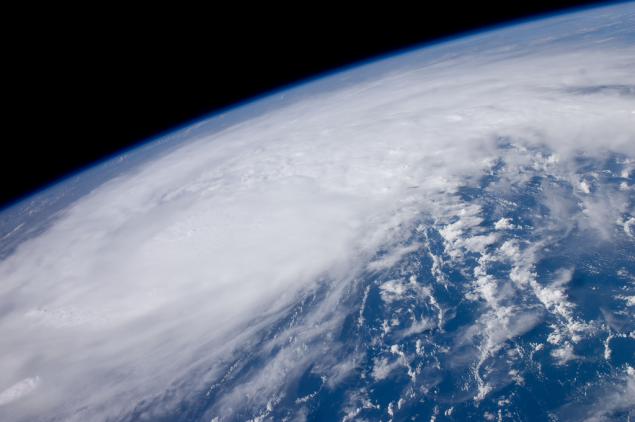
Mercury

The surface of the planet Mercury resembles a moon
Although the atmosphere of Mercury is not all, the climate here, yet there. And it creates, of course, the proximity of burning sun. And because the air and water can not effectively transfer heat from one part of the planet to the other, here there is truly lethal temperature drops.
On the day side of Mercury's surface can warm up to 430O C - enough to melt tin and on the night - drop to -180O C. In the background of terrible heat there, at the bottom of some craters so cold that in the eternal shadow of millions of years saved rather dirty ice .
Mercury's rotation axis is not tilted, like Earth, and strictly perpendicular to the orbit. Therefore, the change of seasons is not polyubueshsya: same weather is all year round. In addition to this and the day on the planet lasts for about half of our year.
Venus

The craters on the surface of Venus
Let's face it: the wrong planet called Venus. Yes, in the dawn sky, it really shines as a pure gem. But it's not until you get to know her better. Neighboring planets can be seen as a visual aid on the fact that he is able to create all gone over the border greenhouse effect.
The atmosphere of Venus is incredibly dense, restless and aggressive. Consisting mostly of carbon dioxide it absorbs more solar energy than the same Mercury, but is much further from the sun it. Therefore, even hotter planet: almost without changing the course of the year, the temperature is kept in the area of 480O C. Throw in atmospheric pressure, which the world can get except that plunged into the ocean at a depth of kilometers, and you will not want to be here.
But that's not the whole truth about the bad character beauty. On the surface of Venus constantly erupt powerful volcanoes, filling the atmosphere with soot and sulfur compounds, which are rapidly converted into sulfuric acid. Yes, on this planet are acid rain - and really acid, which easily would have left a wound on the skin, and corroded photo equipment tourists.
However, tourists could not even straighten up here to take a picture: the atmosphere of Venus rotates much faster than its own. On Earth, the air goes around the planet in almost a year on Venus - four hours, creating a permanent hurricane force winds. It is not surprising that until now even specially prepared spacecraft could not survive more than a few minutes in this abominable climate.
Mars

The atmosphere of Mars, the picture received artificial satellite "Viking" in 1976. From left to see "crater-smiley" Halle
Fascinating discoveries that are made on the Red Planet in recent years, show that in the distant past Mars was very different. Billions of years ago it was a wet planet with a good atmosphere and extensive water features. Here and there, it traces the ancient coastline - but it's today here better not to fall. Modern Mars - a naked and dead ice desert on which the matter carried by powerful dust storms.
The dense atmosphere that would retain heat and water on the planet is long gone. As she disappeared, it is still not very clear, but is likely to Mars simply does not have enough "power of attraction": about half of the Earth, it has almost three times less gravity.
As a result, the poles there reigns a deep cold and saved the polar caps, consisting mainly of "dry snow" - frozen carbon dioxide. It should be recognized that the temperature near the equator in the afternoon can be very comfortable, about 20 ° C. But, however, at night she still fall a few tens of degrees below zero.
Although frankly weak Martian atmosphere, snow storm at its poles and the rest of the dust - not a rarity. Sandstorm, and other debilitating Khamsin desert winds that carry a myriad of pervasive and prickly grains of sand, the winds, which in the world are facing only in some regions, there may cover the entire planet, a few days making it quite nefotografiruemoy.
Jupiter and vicinity
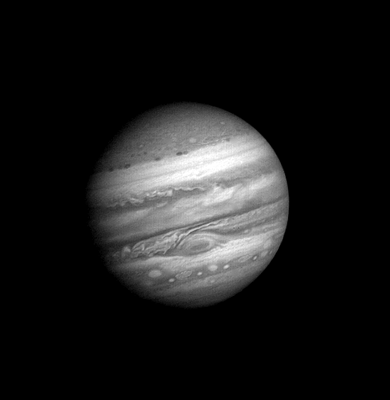
Animation of rotation of Jupiter, created from photographs with the "Voyager 1" 1979
To appreciate the scale of Jovian storms, even powerful telescope is needed. The most impressive of them - the Great Red Spot - has been simmering for several centuries, and has three times the size of our entire Earth. However, he may soon lose the position of the long-term leader. A few years ago, astronomers discovered a Jupiter new vortex - Oval BA, which has not yet reached the size of the Great Red Spot, but is growing alarmingly quickly.
No, Jupiter is unlikely to attract even fans of extreme rest. Hurricane-force winds are blowing constantly, they cover the entire planet, moving at a speed below 500 km / h, often in opposite directions, creating on their borders horrific turbulent eddies (such as familiar to us the Great Red Spot, or Oval BA). < br />
In addition a temperature below -140O C, and lethal force of gravity, it is necessary not to forget about one more fact - there is no place to walk on Jupiter. This planet - a gas giant, generally devoid of a certain hard surface. And even if some desperate skydiver was able to dive into its atmosphere, he would have finished in the semi depths of the planet, where immense gravity creates exotic forms of matter - for example, a metallic superfluid hydrogen.
But ordinary divers should pay attention to one of the moons of the giant planets - Europe. In general, from a plurality of satellites of Jupiter are at least two in the future certainly can claim the title of "tourist Mecca».
For example, Europe is completely covered by an ocean of salt water. Divers here expanse - the depth of up to 100 km - if only to break through the ice crust that covers the entire satellite. No one knows that in the Europe of the future finds a follower of Jacques-Yves Cousteau, some planetary scientists suggested that there may find conditions suitable for life.
Another Jovian satellite - Io, no doubt become a favorite fotoblogerov. The powerful gravity near the huge planet and permanently deform, "squeezes" the satellite and heated to enormous temperatures bowels. This energy breaks through to the surface in areas of geological activity and constantly feeds hundreds of active volcanoes. Because of the weak attraction of the satellite spectacular eruptions spew streams that rise hundreds of kilometers high. Photographers waiting staff are extremely delicious!
Saturn with the "suburbs»
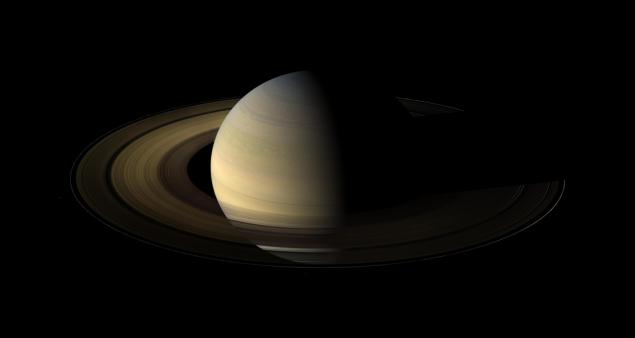
Saturn
Equally appealing in terms of photography, of course, Saturn with its resplendent rings. Of particular interest may be the unusual storm from the north pole of the planet, shaped almost regular hexagon with sides of almost 14 thousand. Km.
But for normal rest Saturn is not adjusted. In general, it is a gas giant, like Jupiter, only worse. The atmosphere is cold and dense, and local storms can move faster than sound and faster than a bullet - fixed rate of more than 1600 km / h.
But the climate of Saturn's moon Titan may attract a crowd of oligarchs. The point, however, is not at all surprising softness of the weather. Titan - only known celestial body on which there is a circulation of liquid on Earth. Only here play the role of water ... liquid hydrocarbons.
The same substances that are in the world make up the main wealth of the country - natural gas (methane) and other combustible compounds - Titan are present in excess, in liquid form: it is cold enough here (-162O C). Methane swirling in the clouds and the rain poured and fills the rivers that flow into the sea almost full ... Swing - not to pump!
Uranium
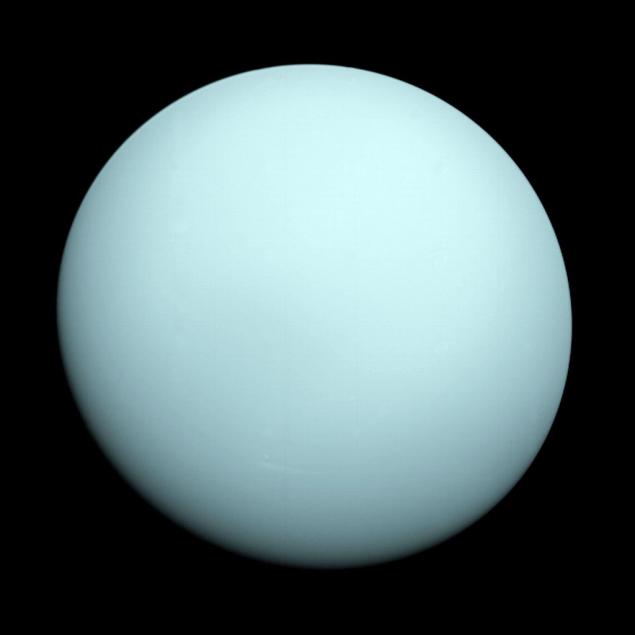
Not very far, but the coldest planet in the Solar System, "thermometer" here can drop to an unpleasant mark -224O C. This slightly warmer than absolute zero. For some reason - perhaps because of a collision with some great body - Uranus rotates lying on its side and the north pole of the planet is turned toward the sun. In addition to powerful hurricanes, there is nothing to see.
Neptune and Triton

Neptune (top) and Triton (below)
Like the other gas giants, Neptune - a place quite hectic. The storms here can reach greater dimensions of our planet and move to the known record speed: nearly 2,500 km / h. The rest - it's a boring place. Visit Neptune is perhaps that of one of his companions - Triton.
In general, the Triton as cold and monotonous, as it is a planet, but tourists are always intriguing all transient and dying. Triton is just one of these: the satellite is slowly moving closer to Neptune, and after some time it will be broken by gravity. Some of the debris will fall on the planet, and some may form a kind of ring, like Saturn. Say exactly when it will happen until you get where some 10 or 100 million years. So should hurry to be in time to see the Triton - the famous "dying companion».
Pluto

Map of rotation of Pluto in a natural color images created on the basis of the space telescope "Hubble»
Stripped of high rank of the planet, Pluto remained in dwarfs, but we can safely say this is a very strange and inhospitable place. Pluto's orbit is very long and strongly stretched into an oval, which is why the year lasts about 250 Earth years. During this time the weather change significantly.
While on dwarf planet reigns winter, it freezes entirely. Approaching the Sun, Pluto is warming up. Surface ice consisting of methane, nitrogen and carbon monoxide begins to evaporate creating atmospheric thin shell. Temporarily Pluto becomes like a full-fledged planet well, and along with a comet: Due to the size of dwarf gas is not kept, and carried away with it, creating a tail. Normal planets do not behave.
All these climatic anomalies are quite clear. Life arose and developed it on Earth, so the local climate is almost perfect for us. Even the most terrible Siberian winter and tropical storms look childish pranks compared to what awaits vacationers on Saturn and Neptune. Therefore, our advice to you for the future: it is not necessary to spend long-awaited day of rest for these exotic places. Better to take care of our own cozy planet, so that when the interplanetary travel will be available to our descendants could rest on the Egyptian beach or just out of town on a clean river.

Mercury

The surface of the planet Mercury resembles a moon
Although the atmosphere of Mercury is not all, the climate here, yet there. And it creates, of course, the proximity of burning sun. And because the air and water can not effectively transfer heat from one part of the planet to the other, here there is truly lethal temperature drops.
On the day side of Mercury's surface can warm up to 430O C - enough to melt tin and on the night - drop to -180O C. In the background of terrible heat there, at the bottom of some craters so cold that in the eternal shadow of millions of years saved rather dirty ice .
Mercury's rotation axis is not tilted, like Earth, and strictly perpendicular to the orbit. Therefore, the change of seasons is not polyubueshsya: same weather is all year round. In addition to this and the day on the planet lasts for about half of our year.
Venus

The craters on the surface of Venus
Let's face it: the wrong planet called Venus. Yes, in the dawn sky, it really shines as a pure gem. But it's not until you get to know her better. Neighboring planets can be seen as a visual aid on the fact that he is able to create all gone over the border greenhouse effect.
The atmosphere of Venus is incredibly dense, restless and aggressive. Consisting mostly of carbon dioxide it absorbs more solar energy than the same Mercury, but is much further from the sun it. Therefore, even hotter planet: almost without changing the course of the year, the temperature is kept in the area of 480O C. Throw in atmospheric pressure, which the world can get except that plunged into the ocean at a depth of kilometers, and you will not want to be here.
But that's not the whole truth about the bad character beauty. On the surface of Venus constantly erupt powerful volcanoes, filling the atmosphere with soot and sulfur compounds, which are rapidly converted into sulfuric acid. Yes, on this planet are acid rain - and really acid, which easily would have left a wound on the skin, and corroded photo equipment tourists.
However, tourists could not even straighten up here to take a picture: the atmosphere of Venus rotates much faster than its own. On Earth, the air goes around the planet in almost a year on Venus - four hours, creating a permanent hurricane force winds. It is not surprising that until now even specially prepared spacecraft could not survive more than a few minutes in this abominable climate.
Mars

The atmosphere of Mars, the picture received artificial satellite "Viking" in 1976. From left to see "crater-smiley" Halle
Fascinating discoveries that are made on the Red Planet in recent years, show that in the distant past Mars was very different. Billions of years ago it was a wet planet with a good atmosphere and extensive water features. Here and there, it traces the ancient coastline - but it's today here better not to fall. Modern Mars - a naked and dead ice desert on which the matter carried by powerful dust storms.
The dense atmosphere that would retain heat and water on the planet is long gone. As she disappeared, it is still not very clear, but is likely to Mars simply does not have enough "power of attraction": about half of the Earth, it has almost three times less gravity.
As a result, the poles there reigns a deep cold and saved the polar caps, consisting mainly of "dry snow" - frozen carbon dioxide. It should be recognized that the temperature near the equator in the afternoon can be very comfortable, about 20 ° C. But, however, at night she still fall a few tens of degrees below zero.
Although frankly weak Martian atmosphere, snow storm at its poles and the rest of the dust - not a rarity. Sandstorm, and other debilitating Khamsin desert winds that carry a myriad of pervasive and prickly grains of sand, the winds, which in the world are facing only in some regions, there may cover the entire planet, a few days making it quite nefotografiruemoy.
Jupiter and vicinity

Animation of rotation of Jupiter, created from photographs with the "Voyager 1" 1979
To appreciate the scale of Jovian storms, even powerful telescope is needed. The most impressive of them - the Great Red Spot - has been simmering for several centuries, and has three times the size of our entire Earth. However, he may soon lose the position of the long-term leader. A few years ago, astronomers discovered a Jupiter new vortex - Oval BA, which has not yet reached the size of the Great Red Spot, but is growing alarmingly quickly.
No, Jupiter is unlikely to attract even fans of extreme rest. Hurricane-force winds are blowing constantly, they cover the entire planet, moving at a speed below 500 km / h, often in opposite directions, creating on their borders horrific turbulent eddies (such as familiar to us the Great Red Spot, or Oval BA). < br />
In addition a temperature below -140O C, and lethal force of gravity, it is necessary not to forget about one more fact - there is no place to walk on Jupiter. This planet - a gas giant, generally devoid of a certain hard surface. And even if some desperate skydiver was able to dive into its atmosphere, he would have finished in the semi depths of the planet, where immense gravity creates exotic forms of matter - for example, a metallic superfluid hydrogen.
But ordinary divers should pay attention to one of the moons of the giant planets - Europe. In general, from a plurality of satellites of Jupiter are at least two in the future certainly can claim the title of "tourist Mecca».
For example, Europe is completely covered by an ocean of salt water. Divers here expanse - the depth of up to 100 km - if only to break through the ice crust that covers the entire satellite. No one knows that in the Europe of the future finds a follower of Jacques-Yves Cousteau, some planetary scientists suggested that there may find conditions suitable for life.
Another Jovian satellite - Io, no doubt become a favorite fotoblogerov. The powerful gravity near the huge planet and permanently deform, "squeezes" the satellite and heated to enormous temperatures bowels. This energy breaks through to the surface in areas of geological activity and constantly feeds hundreds of active volcanoes. Because of the weak attraction of the satellite spectacular eruptions spew streams that rise hundreds of kilometers high. Photographers waiting staff are extremely delicious!
Saturn with the "suburbs»

Saturn
Equally appealing in terms of photography, of course, Saturn with its resplendent rings. Of particular interest may be the unusual storm from the north pole of the planet, shaped almost regular hexagon with sides of almost 14 thousand. Km.
But for normal rest Saturn is not adjusted. In general, it is a gas giant, like Jupiter, only worse. The atmosphere is cold and dense, and local storms can move faster than sound and faster than a bullet - fixed rate of more than 1600 km / h.
But the climate of Saturn's moon Titan may attract a crowd of oligarchs. The point, however, is not at all surprising softness of the weather. Titan - only known celestial body on which there is a circulation of liquid on Earth. Only here play the role of water ... liquid hydrocarbons.
The same substances that are in the world make up the main wealth of the country - natural gas (methane) and other combustible compounds - Titan are present in excess, in liquid form: it is cold enough here (-162O C). Methane swirling in the clouds and the rain poured and fills the rivers that flow into the sea almost full ... Swing - not to pump!
Uranium

Not very far, but the coldest planet in the Solar System, "thermometer" here can drop to an unpleasant mark -224O C. This slightly warmer than absolute zero. For some reason - perhaps because of a collision with some great body - Uranus rotates lying on its side and the north pole of the planet is turned toward the sun. In addition to powerful hurricanes, there is nothing to see.
Neptune and Triton

Neptune (top) and Triton (below)
Like the other gas giants, Neptune - a place quite hectic. The storms here can reach greater dimensions of our planet and move to the known record speed: nearly 2,500 km / h. The rest - it's a boring place. Visit Neptune is perhaps that of one of his companions - Triton.
In general, the Triton as cold and monotonous, as it is a planet, but tourists are always intriguing all transient and dying. Triton is just one of these: the satellite is slowly moving closer to Neptune, and after some time it will be broken by gravity. Some of the debris will fall on the planet, and some may form a kind of ring, like Saturn. Say exactly when it will happen until you get where some 10 or 100 million years. So should hurry to be in time to see the Triton - the famous "dying companion».
Pluto

Map of rotation of Pluto in a natural color images created on the basis of the space telescope "Hubble»
Stripped of high rank of the planet, Pluto remained in dwarfs, but we can safely say this is a very strange and inhospitable place. Pluto's orbit is very long and strongly stretched into an oval, which is why the year lasts about 250 Earth years. During this time the weather change significantly.
While on dwarf planet reigns winter, it freezes entirely. Approaching the Sun, Pluto is warming up. Surface ice consisting of methane, nitrogen and carbon monoxide begins to evaporate creating atmospheric thin shell. Temporarily Pluto becomes like a full-fledged planet well, and along with a comet: Due to the size of dwarf gas is not kept, and carried away with it, creating a tail. Normal planets do not behave.
All these climatic anomalies are quite clear. Life arose and developed it on Earth, so the local climate is almost perfect for us. Even the most terrible Siberian winter and tropical storms look childish pranks compared to what awaits vacationers on Saturn and Neptune. Therefore, our advice to you for the future: it is not necessary to spend long-awaited day of rest for these exotic places. Better to take care of our own cozy planet, so that when the interplanetary travel will be available to our descendants could rest on the Egyptian beach or just out of town on a clean river.




